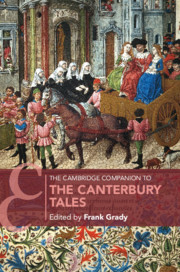Book contents
- The Cambridge Companion to The Canterbury Tales
- The Cambridge Companion to The Canterbury Tales
- Copyright page
- Contents
- Illustrations
- Contributors
- Preface
- Note on the Text
- Chronology
- Abbreviations
- 1 The Form of the Canterbury Tales
- 2 Manuscripts, Scribes, Circulation
- 3 The General Prologue
- 4 The Knight’s Tale and the Estrangements of Form
- 5 The Miller’s Tale and the Art of Solaas
- 6 The Man of Law’s Tale
- 7 The Wife of Bath’s Prologue and Tale
- 8 The Friar’s Tale and TheSummoner’s Tale in Word and Deed
- 9 Griselda and the Problem of the Human in The Clerk’s Tale
- 10 The Franklin’s Symptomatic Sursanure
- 11 The Pardoner and His Tale
- 12 The Prioress’s Tale
- 13 The Nun’s Priest’s Tale
- 14 Moral Chaucer
- 15 Chaucer’s Sense of an Ending
- 16 Postscript: How to Talk about Chaucer with Your Friends and Colleagues
- Further Reading
- Index
- Cambridge Companions to …
15 - Chaucer’s Sense of an Ending
Published online by Cambridge University Press: 21 August 2020
- The Cambridge Companion to The Canterbury Tales
- The Cambridge Companion to The Canterbury Tales
- Copyright page
- Contents
- Illustrations
- Contributors
- Preface
- Note on the Text
- Chronology
- Abbreviations
- 1 The Form of the Canterbury Tales
- 2 Manuscripts, Scribes, Circulation
- 3 The General Prologue
- 4 The Knight’s Tale and the Estrangements of Form
- 5 The Miller’s Tale and the Art of Solaas
- 6 The Man of Law’s Tale
- 7 The Wife of Bath’s Prologue and Tale
- 8 The Friar’s Tale and TheSummoner’s Tale in Word and Deed
- 9 Griselda and the Problem of the Human in The Clerk’s Tale
- 10 The Franklin’s Symptomatic Sursanure
- 11 The Pardoner and His Tale
- 12 The Prioress’s Tale
- 13 The Nun’s Priest’s Tale
- 14 Moral Chaucer
- 15 Chaucer’s Sense of an Ending
- 16 Postscript: How to Talk about Chaucer with Your Friends and Colleagues
- Further Reading
- Index
- Cambridge Companions to …
Summary
Through its overarching frame story but also in the interplay among its diverse tales, the Canterbury Tales again and again troubles our sense of how endings work, promising resolutions that never quite materialize or are undercut as soon as they do. This feature of the Tales offers us the opportunity to consider endings less as a single narrative feature than as a set of persistent and varied problems related to composition, to language, to audience, and to poetry, as a way of considering the cadence of life itself. We follow Rosemarie McGerr in asserting that a certain kind of “irresolution” is a defining feature of the Chaucerian poetic, a poetic of openness and ambiguity, a consideration of the limits and problems of teleology for the poetic enterprise, for an audience of hearers, or for human living. The poet’s troubles with endings date from the start of his career, with his earliest major poem, the Book of the Duchess, offering a particularly useful example, and they extend past the poet’s own ending, as Chaucer’s fifteenth-century audience saw the Canterbury Tales both as an “open” text, ripe for additions, and as an “unfinished” text, a structure begging to be completed.
- Type
- Chapter
- Information
- The Cambridge Companion to The Canterbury Tales , pp. 218 - 231Publisher: Cambridge University PressPrint publication year: 2020

